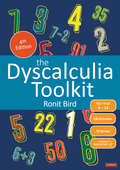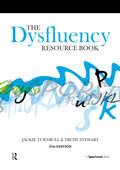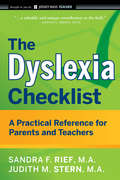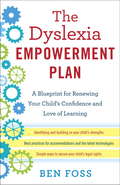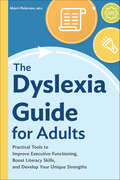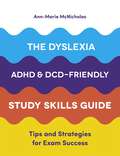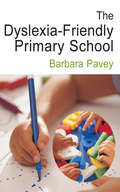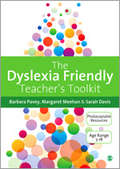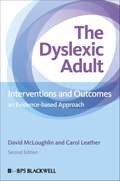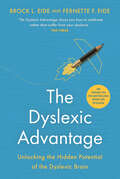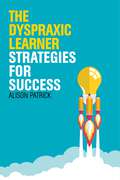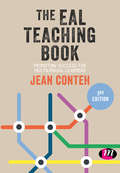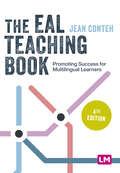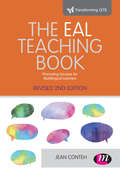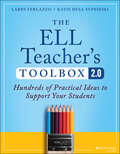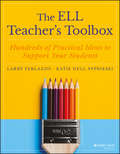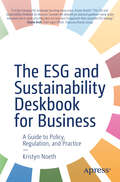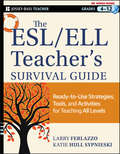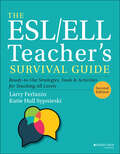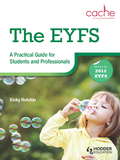- Table View
- List View
The Dyscalculia Toolkit: Supporting Learning Difficulties in Maths (Corwin Ltd)
by Ronit BirdDesigned for all teachers, this book provides a wealth of materials and resources to support the needs of learners, aged 6 to 14 years, who have difficulty with maths and number. Packed full with 220 activities and 55 games, the author provides you with a complete toolkit to enable you to understand dyscalculia and implement practical and innovative strategies to use in the classroom or at home. This fourth edition is updated with new content including: - more on dice and board games, multiplication and division; - new downloadable and printable teaching materials (including tracking sheets, activity sheets, game boards and teaching resources); - updated videos.
The Dysfluency Resource Book
by Jackie Turnbull Trudy StewartThis is a comprehensive resource book for treating adults who stammer. Completely revised and updated to take account of current practice, this new edition draws together the latest information on therapy for adults along with practical examples of exercises, tasks and activities that can be used for both individual and group programmes. With new chapters and therapy ideas, this is an extremely useful resource for all speech & language therapists and students working with adults who stammer. This useful resource seeks to explain techniques for treating people who stammer and the rationale for their use. This volume forms a catalogue of treatment options from which clinicians may choose to use all of the techniques or pick out particular sections according to their clients' special requirements. The first edition of this book proved to be a very useful tool for speech and language professionals, and this new edition has come about largely because clinicians, speech and language therapists and teachers have requested it. With the inclusion of 50 photocopiable handouts and the presentation of the chapters in the order they would use with their own group programmes, the authors set out the principles of therapy in such a way that the treatment techniques fit into a clear management approach. Trudy Stewart is a specialist in dysfluency and has been a service manager since 1986. She studied in America and obtained her PhD in 1991. Jackie Turnbull retired from SLT in July 2009 after 40 years in the profession, over 35 of which were spent as a specialist in dysfluency, working with children and adults. She also worked for many years as a staff counsellor in a large hospital. The collaboration that has grown up between the two of them has sparked further study in stammering. Together they have developed a highly creative clinical practice which has national recognition.
The Dyslexia Checklist
by Sandra F. Rief Judith Stern M.A.Essential advice and resources for helping kids with dyslexiaThe Dyslexia Checklist is a valuable guide for parents and teachers that can help them better understand children and teenagers with dyslexia and other reading- and language-based disabilities. The book relays the most current research available and is filled with practical strategies, supports, and interventions. Using these tools teachers and parents can accommodate the needs and strengthen the skills of students with reading and writing disabilities across all age levels. The book is presented in a simple, concise, easy-to-read checklist format and is filled with useful advice and information on a wide range of topics.Explains what we now know about dyslexia from decades of researchContains games to strengthen a child's literacy and language skillsProvides important information for hooking in reluctant and struggling readersOffers suggestions for enhancing skills in vocabulary, comprehension, composition and written expression, spelling, math, and moreThe book also provides information on the educational rights of students with dyslexia.
The Dyslexia Empowerment Plan
by Ben FossFinally, a groundbreaking book that reveals what your dyslexic child is experiencing--and what you can do so that he or she will thrive More than thirty million people in the United States are dyslexic--a brain-based genetic trait, often labeled as a "learning disability" or "learning difference," that makes interpreting text and reading difficult. Yet even though children with dyslexia may have trouble reading, they don't have any problems learning; dyslexia has nothing to do with a lack of intellect. While other books tell you what dyslexia is, this book tells you what to do. Dyslexics' innate skills, which may include verbal, social, spatial, kinesthetic, visual, mathematical, or musical abilities, are their unique key to acquiring knowledge. Figuring out where their individual strengths lie, and then harnessing these skills, offers an entrée into learning and excelling. And by keeping the focus on learning, not on standard reading the same way everyone else does, a child with dyslexia can and will develop the self-confidence to flourish in the classroom and beyond. After years of battling with a school system that did not understand his dyslexia and the shame that accompanied it, renowned activist and entrepreneur Ben Foss is not only open about his dyslexia, he is proud of it. In The Dyslexia Empowerment Plan he shares his personal triumphs and failures so that you can learn from his experiences, and provides a three-step approach for success: * Identify your child's profile: By mapping your child's strengths and weaknesses and assisting her to better understand who she is, you can help your child move away from shame and feelings of inadequacy and move toward creating a powerful program for learning. * Help your child help himself: Coach your child to become his own best advocate by developing resiliency, confidence, and self-awareness, and focusing on achievable goals in areas that matter most to him. * Create community: Dyslexic children are not broken, but too often the system designed to educate them is. Dare to change your school so that your child has the resources to thrive. Understanding your rights and finding allies will make you and your child feel connected and no longer alone. Packed with practical ideas and strategies dyslexic children need for excelling in school and in life, this empowering guide provides the framework for charting a future for your child that is bright with hope and unlimited potential.Advance praise for The Dyslexia Empowerment Plan "I study dyslexia in the lab and am a parent of a wonderful daughter who fits this profile. Ben Foss's book should be considered essential to any collection on the subject. It was extremely useful, especially for a mom. Thank you!"--Maria Luisa Gorno Tempini, M.D., Ph.D., professor of neurology, UCSF, Memory and Aging Center "As someone with a learning profile that made school tough, and as a parent, I know kids need the right support. Ben Foss knows how to get access to education because he's been through it. I was thrilled to read this book. It offers a wise collection of insights that are both practical and touching. Buy it today if you want a get a plan for your child."--James Gandolfini, actor, The Sopranos
The Dyslexia Guide for Adults: Practical Tools to Improve Executive Functioning, Boost Literacy Skills, and Develop Your Unique Strengths
by Marci PetersonLearn how to thrive with dyslexia as an adultNo matter when you're diagnosed, living with dyslexia can be a challenge—but it can also make you a unique and creative thinker. The Dyslexia Guide for Adults helps you boost your confidence with advice for embracing your greatest strengths. With these proven strategies and exercises, you'll learn to understand yourself better as you navigate social situations, the workplace, and beyond.Dyslexia in adulthood—Find out how dyslexia looks different in adults than in children and the impact it can have on your life as you get older.Proven strategies—Learn evidence-based techniques for coping with dyslexia and identifying what you need to succeed in any environment.You're not alone—Discover stories from other adults with dyslexia and see how they've used these strategies in their own lives to find greater self-confidence.Take control of your dyslexia with guidance for improving literacy and executive function in adults.
The Dyslexia Workbook for Adults: Practical Tools to Improve Executive Functioning, Boost Literacy Skills, and Develop Your Unique Strengths
by Gavin ReidImprove your skills and discover the strengths of your dyslexia—strategies and exercises for adultsDyslexia is a continuous, lifelong journey—one that asks you to adapt and grow every day. The Dyslexia Workbook for Adults offers practical tools, techniques, and activities to help you improve your literacy skills, boost your self-esteem, and use your dyslexia as an advantage.Gain a sense of empowerment and a greater appreciation for the positive aspects of dyslexia with exercises designed to develop the strengths unique to dyslexic patterns of thinking. Explore specific strategies for targeting problems that adults with dyslexia experience with spelling, reading, writing, memorization, organization, and other executive functioning skills. You'll come to see your dyslexia as a gift and an important part of you.The Dyslexia Workbook for Adults includes:Intro to dyslexia—Learn more about dyslexia and how it impacts adults, and take an assessment of your own experience with the characteristics of dyslexia.Coping strategies—Build resilience to dyslexia-specific stressors in your personal life and the workplace with actionable coping techniques.Dyslexia in action—Read real-life scenarios that depict people with dyslexia using a variety of strategies and employing their strengths to overcome challenges and thrive.Build greater confidence and stronger literacy skills with evidence-based tools and exercises for adults with dyslexia.
The Dyslexia, ADHD, and DCD-Friendly Study Skills Guide: Tips and Strategies for Exam Success
by Ann-Marie McNicholasThis practical skills guide helps young people with who learn differently including those with dyslexia, DCD/dyspraxia and ADHD, study for their exams.Students who learn differently can often find exams challenging and can experience a good deal of anxiety around exam time, leading to exam results that may not accurately reflect their capabilities. Much exam stress arises from a lack of confidence with the ability to learn and retain information in a meaningful way. This engaging workbook is designed to help students to overcome these issues. It not only shows students how to develop a positive success attitude towards study and exams, but also aims to equip them with powerful strategies and techniques for learning and remembering. The book offers strategies for learners whose methods of learning are multisensory. When learning is active rather than passive, it happens faster, and is easier, more enjoyable and more effective. As you progress through the fun, engaging activities, so your confidence and belief in your ability to learn will increase. Struggling students will become confident, successful learners, with a positive attitude and access to a wide range of effective strategies, and in this way, you will achieve the results in exams that you have worked for and deserve.
The Dyslexia-Friendly Primary School: A Practical Guide for Teachers
by Barbara PaveyIs your school dyslexia-friendly? Beginning with a look at understanding dyslexia, this book shows you how to involve the whole school in order to achieve a dyslexia-friendly environment. You will be able to: - use an audit tool to discover how dyslexia-friendly your school is - look at examples of successful dyslexia-friendly initiatives - find information on funding and resources. This book offers a step-by-step guide to creating a dyslexia-friendly classroom and whole-school environment. Headteachers, deputy headteachers, class teachers, SENCOs, student teachers and literacy co-ordinators wanting to make their school more dyslexia-friendly will find this practical book extremely useful. Barbara Pavey worked as a teacher and SEN specialist for many years and is now Lecturer in Learning Disabilities at The University of Manchester.
The Dyslexia-Friendly Teacher's Toolkit: Strategies for Teaching Students 3-18
by Barbara Pavey Margaret Meehan Sarah Davis'This book is a really practical, hands-on guide packed woth a wealth of advice on strategies and "things to try" reflecting the authors' extensive experience. If you want to make effective, inclusive dyslexia-friendly classrooms a reality rather than an aspiration, this book is for you'-Dr John P. Rack, Head of Research and Development, Dyslexia Action In this toolkit the authors provide you with the foundations for making your setting and your teaching style dyslexia-friendly. There is a general overview of the principles and practices required, and what the dyslexia-aware teacher needs to bear in mind. Chapters cover: - understanding learners with dyslexia; - dyslexia and phonics; - dyslexia and English as an Additional Language; - dyslexia and mathematics; - dyslexia and science; - dyslexia and creativity. Each chapter includes visual chapter overviews, tried and tested strategies for the classroom and the whole school, using technology to help learners, case studies from practice, children's voices and sources of further information. The book offers you ideas and advice, and will ensure you feel confident you are doing the right things to help overcome barriers to learning. Barbara Pavey is a lecturer in Higher Education, training dyslexia specialists in the North of England. Margaret Meehan is Coordinator of Specialist Tuition at Swansea University Sarah Davis is an Early Years Leading Teacher working in North Yorkshire
The Dyslexic Adult
by Carol Leather David McloughlinA definitive and evidence-based guide for psychologists, teachers, coaches, HR personnel and all professionals who must understand and work with dyslexic adults.The only book to look at dyslexia within the context of life span developmental psychology, including the factors that contribute to success - now fully revised and updatedCombines an accessible style with a strong focus on evidence-based practice and a sound theoretical model on which to base assessment, counselling, teaching and trainingProvides a clear guide to the kinds of assessment that can be conducted and the ways in which dyslexic adults can be supported in selection, training, education and employmentIncludes coverage of overlapping syndromes such as dyspraxia and dyscalculia, and up-to-date check lists for syndromes that can be used as part of the assessment process
The Dyslexic Advantage (New Edition): Unlocking the Hidden Potential of the Dyslexic Brain
by Brock L. Eide Fernette F. EideA MAJOR REVISION WITH BRAND-NEW MATERIAL. Discover how the unique strengths of dyslexia can be channelled for success at home, school and work with this ground-breaking exploration of the dyslexic brain.In this paradigm-shifting book, neuro-learning experts Dr Brock L. Eide and Dr Fernette F. Eide describe a new brain science revealing that people with dyslexia have unique brain structure and organization. While the differences are responsible for challenges with literacy and reading, the dyslexic brain also gives a predisposition to important skills and special talents. This transformational new edition includes:- significantly updated chapters on the neurobiology underlying dyslexia and dyslexic strengths- ground-breaking science and interviews with successful dyslexics and innovative teachersWith much-needed prescriptive advice for parents, educators, co-workers and dyslexics, The Dyslexic Advantage provides a new framework to create a fuller, more balanced and more useful model of dyslexia. The authors of this essential book show how the unique strengths of dyslexia can lead to amazing success.
The Dyspraxic Learner: Strategies for Success
by Alison PatrickWith a wealth of practical strategies for teaching and supporting students with dyspraxia aged from 11 years up to college or university level, this book addresses all aspects of learning and ways in which teaching can be tailored to the dyspraxic learner. By exploring dyspraxia and its physical, emotional, psychological and social impacts on learning, the author shares tried-and-tested strategies for ensuring that students with dyspraxia achieve their full potential. This book covers a wide range of topics, such as research and study skills, improving memory, teaching literacy, visual and auditory learning styles, dealing with sleeplessness, stress, low self-esteem and anxiety, and preparing for future employment. Teachers will have a greater understanding of dyspraxia, and feel confident in helping students with dyspraxia to overcome educational challenges. Teachers, lecturers, tutors and SENCOs will find this book useful, and it will also be of interest to students with dyspraxia who are looking for ways to help themselves with their school or university work.
The EAL Teaching Book: Promoting Success for Multilingual Learners (Primary Teaching Now)
by Jean ContehThis book is a complete guide to understanding, learning from and teaching bilingual and EAL children in schools. It begins by asking 'who are EAL learners' and challenges some of the misconceptions about this group. It goes on to examine language in depth, providing focused theory to help teachers and trainees better understand the wider context of children's needs. This theory is supported by a wealth of information on practical teaching strategies and resources. It also covers planning across the curriculum for EAL, assessing EAL and bilingual learners and classroom organisation. New to this second edition is a chapter on using home languages and cultures in learning as well many new case studies from practising teachers offering insight and knowledge on teaching this particular group.
The EAL Teaching Book: Promoting Success for Multilingual Learners (Primary Teaching Now)
by Jean ContehThis book is a complete guide to understanding, learning from and teaching bilingual and EAL children in schools. It begins by asking 'who are EAL learners' and challenges some of the misconceptions about this group. It goes on to examine language in depth, providing focused theory to help teachers and trainees better understand the wider context of children's needs. This theory is supported by a wealth of information on practical teaching strategies and resources. It also covers planning across the curriculum for EAL, assessing EAL and bilingual learners and classroom organisation. New to this second edition is a chapter on using home languages and cultures in learning as well many new case studies from practising teachers offering insight and knowledge on teaching this particular group.
The EAL Teaching Book: Promoting Success for Multilingual Learners (Primary Teaching Now)
by Jean ContehAs the number of children for whom English is an Additional Language in schools increases, how do teachers and trainees prepare to support them to succeed? A complete guide to understanding, learning from and teaching bilingual and EAL children in schools. The text begins by asking ′who are EAL learners′ and challenges some of the misconceptions about this group. It goes on to examine language in depth, providing focused theory to help teachers and trainees better understand the wider context of children′s needs. This theory is supported by a wealth of information on practical teaching strategies and resources in the promoting learning section. The text covers planning across the curriculum for EAL and offers day-to-day practical support for teachers. The fourth edition is updated throughout and includes a new chapter on EAL and SEND.
The EAL Teaching Book: Promoting Success for Multilingual Learners (Primary Teaching Now)
by Jean ContehAs the number of children for whom English is an Additional Language in schools increases, how do teachers and trainees prepare to support them to succeed? A complete guide to understanding, learning from and teaching bilingual and EAL children in schools. The text begins by asking ′who are EAL learners′ and challenges some of the misconceptions about this group. It goes on to examine language in depth, providing focused theory to help teachers and trainees better understand the wider context of children′s needs. This theory is supported by a wealth of information on practical teaching strategies and resources in the promoting learning section. The text covers planning across the curriculum for EAL and offers day-to-day practical support for teachers. The fourth edition is updated throughout and includes a new chapter on EAL and SEND.
The EAL Teaching book: Promoting success for multilingual learners (Transforming Primary QTS Series)
by Jean ContehAs the number of children for whom English is an Additional Language in schools increases, how do teachers and trainees prepare to support them to succeed? This text is their toolkit. A complete guide to understanding, learning from and teaching bilingual and EAL children in schools. The text begins by asking 'who are EAL learners' and challenges some of the misconceptions about this group. It goes on to examine language in depth, providing focused theory to help teachers and trainees better understand the wider context of children's needs. This theory is supported by a wealth of information on practical teaching strategies and resources in the promoting learning section. The text covers planning across the curriculum for EAL, assessing EAL and bilingual learners and classroom organisation, offering day-to-day practical support for teachers. New to this second edition is a chapter on Using home languages and cultures in learning as well many new case studies from practising teachers offering insight and knowledge on teaching this particular group.
The ECO Guide to Careers that Make a Difference: Environmental Work For A Sustainable World
by Kevin Doyle Kevin Environmental Careers OrganizationECO Guide immerses you in the strategies and tactics that leading edge professionals are using to tackle pressing problems and create innovative solutions.
The ELL Teacher's Toolbox 2.0: Hundreds of Practical Ideas to Support Your Students (The Teacher's Toolbox Series)
by Larry Ferlazzo Katie Hull SypnieskiSet your English language learners up for success with this effective resource The ELL Teacher's Toolbox 2.0 is a valuable, updated resource that teachers of English Language Learners (ELLs) can use to improve student outcomes. With hundreds of innovative strategies and activities to bring to your classroom, this book can be used with learners of all levels and in any instructional setting. This revised edition provides the latest enhancements to the instructional tools—along with 16 new chapters that you can add to your teaching repertoire. New content includes coverage of artificial intelligence, online learning environments, and differentiated instruction. Graphics and visuals make it easy to understand and adapt the content to your unique teaching situation. Written by proven authors in the field, the book is divided into two main sections: Reading/Writing and Speaking/Listening. Each of those sections includes “Top Ten” favorites and between 40 and 70 strategies that can be used as part of multiple lessons and across content areas. Contains 60% new strategies Features ready-to-use lesson plans Includes reproducible handouts Offers technology integration ideas For the growing number of ELLs in public schools, effective ELL instruction can mean the difference between long-term academic success and continued struggling. In this book, you'll find countless practical ideas to add to your teaching arsenal—or for training and coaching ELL teachers—so you can support your students on their journey.
The ELL Teacher's Toolbox: Hundreds of Practical Ideas to Support Your Students (The Teacher's Toolbox Series)
by Larry Ferlazzo Katie Hull SypnieskiPractical strategies to support your English language learners The ELL Teacher’s Toolbox is a practical, valuable resource to be used by teachers of English Language Learners, in teacher education credential programs, and by staff development professionals and coaches. It provides hundreds of innovative and research-based instructional strategies you can use to support all levels of English Language Learners. Written by proven authors in the field, the book is divided into two main sections: Reading/Writing and Speaking/Listening. Each of those sections includes “Top Ten” favorites and between 40 and 70 strategies that can be used as part of multiple lessons and across content areas. Contains 60% new strategies Features ready-to-use lesson plans Includes reproducible handouts Offers technology integration ideas The percentage of public school students in the U.S. who are English language learners grows each year—and with this book, you’ll get a ton of fresh, innovative strategies to add to your teaching arsenal.
The EMC Write-in Reader: Reading Strategies and Test Practice ( Cedar Level)
by Laurie SkibaA Literature and Language Arts textbook, The EMC Write-In Reader offers a rich reading experience, skill development, and standardized test practice.
The ESG and Sustainability Deskbook for Business: A Guide to Policy, Regulation, and Practice
by Kristyn NoethThe interest in sustainability and environmental, social, and governance (ESG) from stakeholders across all sectors is growing and will continue to do so as we are in the most pivotal decade for meeting the global goals on climate change and sustainable development. This book is a compendium of the international agreements, regulatory advancements, and current practicum to inform a 360-degree viewpoint of the organizations, frameworks, and stakeholders that shape the evolving landscape.Written in a straightforward and conversational tone, you’ll embark on a knowledge journey on the progression of ESG and sustainability and how it directly shapes and informs current practice. It provides insights, discussion, and topical briefings as a side-by-side reader to accompany the rise of ESG and sustainability in business and the markets. The flow of information and reader education begins with the origins of sustainability in international treaties and policy. It then moves on to theadvent and differentiation of ESG, sustainability, and social responsibility; provides substantive issue briefings on the key “E,” “S,” and “G” factors. You’ll continue by walking through the global regulatory and standards paradigms; delve into ESG ratings and indices; and examine in-depth analysis of the respective roles of the corporation, the financial and investment sector, the international bodies, the business interest groups, the NGOs and third-party organizations, and the philanthropic community. You’ll also see that corporations and investors are advancing ESG and sustainability strategies and programs at a record pace. What were once regarded as “nice-to-have” initiatives with voluntary reporting have moved into the regulated sphere with mandatory public disclosures and reporting requirements on greenhouse gas emissions, climate risk and transition planning, biodiversity and nature-related impacts, supply chain transparency, anti-bribery and corruption, humanrights, human capital, and board diversity. The ESG and Sustainability Deskbook for Business threads the needle with best practices, case studies, and takeaways to illustrate the applications and to enhance understanding.What You Will LearnStudy the progression of ESG and sustainability and how related considerations increasingly drive business, policy, and economic decisionsReview Takeaways and best practices to provide insights and discussion pointsUnderstand the critical differences between ESG, social responsibility, and sustainabilityWho This Book is ForESG and Sustainability Practitioners (across all sectors), Corporate leadership, Tech sector (a key growth area for compliance, reporting, and GHG accounting), Investors, Compliance, risk, legal, and corporate governance professionals, Management and board consultants
The ESL / ELL Teacher's Survival Guide
by Larry Ferlazzo Katie Hull SypnieskiA much-needed resource for teaching English to all learners The number of English language learners in U. S. schools is projected to grow to twenty-five percent by 2025. Most teachers have English learners in their classrooms, from kindergarten through college. The ESL/ELL Teacher?s Survival Guide offers educators practical strategies for setting up an ESL-friendly classroom, motivating and interacting with students, communicating with parents of English learners, and navigating the challenges inherent in teaching ESL students. Provides research-based instructional techniques which have proven effective with English learners at all proficiency levels Offers thematic units complete with reproducible forms and worksheets, sample lesson plans, and sample student assignments The book?s ESL lessons connect to core standards and technology applications This hands-on resource will give all teachers at all levels the information they need to be effective ESL instructors.
The ESL/ELL Teacher's Survival Guide: Ready-to-Use Strategies, Tools, and Activities for Teaching All Levels (J-b Ed: Survival Guides #175)
by Larry Ferlazzo Katie Hull SypnieskiMaximize the educational potential of your ESL/ELL class with this singular resource The ESL/ELL Teacher's Survival Guide: Ready-to-Use Strategies, Tools, and Activities for Teaching English Language Learners of All Levels, 2nd Edition offers readers a comprehensive range of instructional strategies and educational resources for teaching English. The newly revised 2nd Edition includes brand new chapters on: • Working with Long-Term English Language Learners • Teaching English internationally • Teaching Elementary Age ELLs • Teaching Adult ELLs • Teaching ELLs with learning challenges • Culturally Responsive Instruction • Effective online instruction • Working with co-teachers and para-professionals In addition to the new chapters, The ESL/ELL Teacher's Survival Guide contains updated material on topics including math, science, social studies, Common Core Standards, the Next Generation Science Standards and 150 pages of new, highly engaging content. An essential resource for anyone involved in teaching English as a Second Language to students of all ages, this book is perfect for general education teachers and ESL specialists for students in grades six through twelve. It’s also highly instructive for teachers of adult ESL classes, elementary and teacher educators, and resource specialists.
The EYFS: A Practical Guide for Students and Professionals
by Vicky HutchinEndorsed by CACHE, this is the ideal book for you if you are an early years professional, a Level 2 or Level 3 child care learner, are working in a pre-school or are working as a child minder. This book will de-mystify the revised 2012 Early Years Foundation Stage, and show how you can deliver the new EYFS using the best and most effective standards of professional practice.Each chapter explains a key theme of the EYFS and follows the same model to ensure ease of reading: 'Understanding this theme', 'Looking at children', 'What the experts say' and 'Effective practice'.The most important theory and research relating to each aspect of the EYFS is clearly and simply explained, and suggestions as to how this can influence effective practice are included.Links between child development and the EYFS are demonstrated using carefully analysed observations of children at different ages, highlighting not only common themes but also the uniqueness in every child's learning and development. Case studies in every chapter provide practical examples of best practice and activities help you reflect on and develop your own practice.
